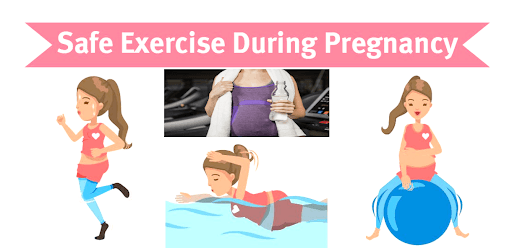
Exercise For 2nd Trimester
Over the next few weeks, you may experience a sense of peace and even an increase in energy due to the realisation that you're here for the long haul. Now, you're in the second trimester of your pregnancy, in weeks 13 to 28 or months 4 to 7. A visible baby bump is one of the most noticeable physical changes.
It's a great time to focus on your exercise program because many women report this is the trimester they feel their best.
Let's learn more about helpful, healthy pregnancy, keeping your fitness level up, and safe exercises to help preserve your pregnancy's health during the second trimester.
Information about Second Trimester Pregnancy Exercise
During the second trimester, there are few physical limitations. As a result, unless your doctor has indicated differently, you can continue with most of the exercises you did throughout your first trimester.
As the uterus grows, experts caution that physical activity should be moderated.
Experts recommend avoiding high-impact activities such as running, jogging, jumping, or fatigue in the second trimester. Any workout that requires you to lay on your back for an extended period is likewise a no-no.
Consider adding some squat variations, such as narrow squats, single-leg squats, and wide stance squats, to your workout routine in the first trimester. Another exercise to incorporate during this trimester is incline push-ups, which work the chest, triceps, and shoulders.
It's much easier to train the core as the abdomen expands now that the fundamental framework has been developed. Pregnant women are advised to continue working on their stability strength, emphasising the inner and gluteal regions.
Exercises During the Second Trimester
Exercise during pregnancy is a crucial part of preparing for motherhood. A healthy pregnant woman's well-being is just as important as the health of her unborn child.
During the second trimester, you can safely perform the following exercises-
- Walking

Walking is the most basic everyday activity you can undertake. It isn't necessary to take a challenging walk. A casual stroll in the park should be enough. Make sure you're dressed in something that's easy to move in and has a decent grip and support.
Walking for 30 to 40 minutes a day maintains your heart healthy while keeping you from overly sedentary. Take it easy and enjoy the experience by moving at a steady but comfortable pace.
- Yoga

Your physical and mental well-being can be improved through yoga. You may find it challenging to deal with stress during the second trimester because of the hormonal changes. Yoga is a great way to enhance flexibility and avoid stiffness.
To keep practising yoga, avoid poses that could endanger your or your baby's safety. If you're new to it, consider taking yoga courses. It's best to start with easy yoga poses and then add breathing exercises (pranayama).
- Jogging

Slow jogging can be a part of your workout routine if you get frequent check-ups and your doctor recommends it. This is for the female joggers out there. Only healthy pregnancies should consider doing jogging.
To keep both you and your baby safe, some guidelines are to follow. If you want to keep a steady speed, you should only jog on level ground.
Stop jogging immediately if you feel fatigued, and take a few minutes to rest. Alternatively, you can run on a treadmill slowly and steadily.
- Swimming

Swimming is a great way to unwind, both physically and mentally. To avoid straining your abdominal muscles, you might try swimming workouts in the pool.
Swimming for about 30 minutes during the second trimester is an excellent exercise.
- Stationary Cycling

As long as you don't mind sitting on an exercise bike and cycling, it may be the most significant way to get in some exercise.
The most straightforward technique to build muscle mass is to use a stationary bike for your workouts. During the second trimester, your belly grows, and you should avoid putting too much stress on it.
- Squats

Strengthening your leg muscles will be especially beneficial as your pregnancy continues, incorporating squats into your exercise routine.
Suppose you don't have a high-risk pregnancy and can do comfortable exercising. You can follow these steps to complete the workout.
- Stand with your feet spread wide apart.
- Squat with your knees bent at a 90-degree angle and your arms extended in front of you at shoulder level.
- Stand up straight after about 3-4 seconds of staying in position.
- Make as many repetitions as possible.
- Don't forget to exhale as you lower yourself and inhale as you rise back up.
- Incline Push-ups

Push-ups are a simple workout that can be replicated more securely. An inclined chest press or fly with mild to moderate weights can be substituted.
How To Practice
- Place your hands shoulder-width apart on the surface of a ledge or railing as you face it.
- Take a few steps backwards into a standing plank, ensuring your back stays straight.
- Slowly lower your chest towards the railing or ledge by bending your arms.
- Return to the beginning posture by straightening your arms.
- Perform two sets of 10 to 12 repetitions each.
- Hip flexor and quadriceps stretch

Due to posture changes, the second trimester is optimal for developing a hip flexor, quadriceps, low back, gluteals, and calves stretching routine.
Your belly tends to sink forward because your centre of gravity shifts, generating shortened hip flexor muscles. You may safely stretch when pregnant with this activity.
How To Practice
- Start by lowering yourself to a kneeling position on the floor. Take a step forward with your left foot, keeping your right knee and your left foot flat on the floor.
- Lunge toward your left foot while maintaining a tall posture until you feel a stretch in the right hip and thigh area.
- Lie down on your back for 30 seconds, then release and repeat two more times.
- Change sides and do it again.
- Mermaid stretch

Pregnancy can strain your diaphragm and ribs, which can cause discomfort.
How To Practice
- Sit down on the ground with your knees bent (or folded) and your feet facing right.
- As you inhale, raise your left arm straight up to the ceiling, then exhale and side bend your torso in a right-facing fashion. In this case, should feel a stretch on the left side.
- Slowly inhale for four long, deep breaths. If you're experiencing pain on the left side, you should stretch in this way.
- Switch directions if you're experiencing pain on your left side. Stretching in both directions in the second trimester can help lessen this risk.
Side-lying leg lifts

It's critical to strengthen your balance and pelvic stabilising muscles before shifting the centre of gravity.
How To Practice
- With your knees bent and stacked on top of each other, lie down on your right side.
- Lift the right half of your body off the floor to create a slight gap between your waist and the ground. This also helps to balance your pelvis.
- Adjust the angle of your left leg in front of you by straightening it. Make sure that your toes point towards the floor by twisting your hips.
- Lift your leg for around three seconds, then inhale for three seconds before returning to the starting position. Make sure you don't lose the space you generated between your waist and the floor when you raise your leg.
- On each side, perform two sets of 8 to 15 repetitions.
Exercise Tips for the Second Trimester
Following guidelines can help you exercise safely and effectively.
- After a workout, have a few healthy snacks on hand. You'll be ravenous at the end of each workout.
- Wear loose, comfy clothing if you're aiming for a non-stretch material.
- Must take precautions to assure your safety before participating in any of these exercises in the first place.
- Rest between sets if necessary. You can go longer than 30 minutes for a 30-minute workout.
- Stay hydrated by carrying a sipper bottle with you at all times.
- Walking or jogging requires you to wear proper footwear. You want a pair that is both comfortable and secure.
Exercise Precautions to Take During the Second Trimester
Pregnancy is a time when your health and well-being should come first. During the second trimester of pregnancy, there are a few things to keep in mind.
- Exercises that put you at risk of falling should be avoided.
- Avoid exercising in a way that causes sudden movement or jerks in your body. Examples include jumping, balancing, shifting sides, and other moves.
- Don't overdo it with the workouts. Doing more than you can handle is not a good idea. It is sufficient to exercise for 30 minutes, three to five times per week.
- If you have abdominal pain or vaginal discharge, you should refrain from physical activity.
- Maintaining a nutritious diet during the second trimester can help you keep up with your exercise routines and increase your energy levels.
- Make an effort to do low-intensity exercises like walking or swimming.
- If your pregnancy develops issues, and your gynaecologist has advised against exercising, don't do it.
- Gynecologists should be consulted before any activity is undertaken by pregnant women who have a history of heart disease, asthma, or diabetes.
Summary
These second-trimester prenatal workouts should simplify you to get started on a regular fitness routine while you're pregnant. However, before attempting any of these activities, be sure to speak with your gynaecologist. You can exercise at a calm and steady pace when you have nothing to fear. If you have any unexpected pain, you must stop and seek extra medical help.





